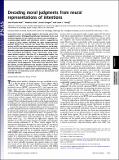Decoding moral judgments from neural representations of intentions
Author(s)
Koster-Hale, Jorie; Saxe, Rebecca R.; Dungan, James; Young, Liane L.
DownloadKoster-Hale-2013-Decoding moral judgm.pdf (471.3Kb)
PUBLISHER_POLICY
Publisher Policy
Article is made available in accordance with the publisher's policy and may be subject to US copyright law. Please refer to the publisher's site for terms of use.
Terms of use
Metadata
Show full item recordAbstract
Intentional harms are typically judged to be morally worse than accidental harms. Distinguishing between intentional harms and accidents depends on the capacity for mental state reasoning (i.e., reasoning about beliefs and intentions), which is supported by a group of brain regions including the right temporo-parietal junction (RTPJ). Prior research has found that interfering with activity in RTPJ can impair mental state reasoning for moral judgment and that high-functioning individuals with autism spectrum disorders make moral judgments based less on intent information than neurotypical participants. Three experiments, using multivoxel pattern analysis, find that (i) in neurotypical adults, the RTPJ shows reliable and distinct spatial patterns of responses across voxels for intentional vs. accidental harms, and (ii) individual differences in this neural pattern predict differences in participants’ moral judgments. These effects are specific to RTPJ. By contrast, (iii) this distinction was absent in adults with autism spectrum disorders. We conclude that multivoxel pattern analysis can detect features of mental state representations (e.g., intent), and that the corresponding neural patterns are behaviorally and clinically relevant.
Date issued
2013-03Department
Massachusetts Institute of Technology. Department of Brain and Cognitive Sciences; McGovern Institute for Brain Research at MITJournal
Proceedings of the National Academy of Sciences
Publisher
National Academy of Sciences (U.S.)
Citation
Koster-Hale, J., R. Saxe, J. Dungan, and L. L. Young. “Decoding moral judgments from neural representations of intentions.” Proceedings of the National Academy of Sciences 110, no. 14 (April 2, 2013): 5648-5653.
Version: Final published version
ISSN
0027-8424
1091-6490